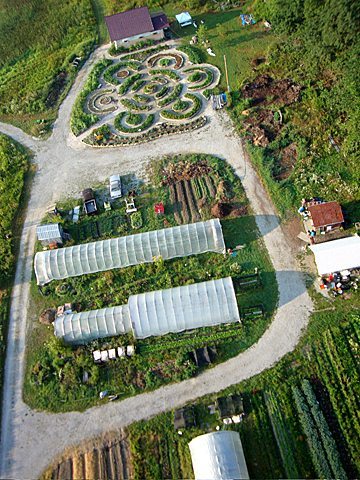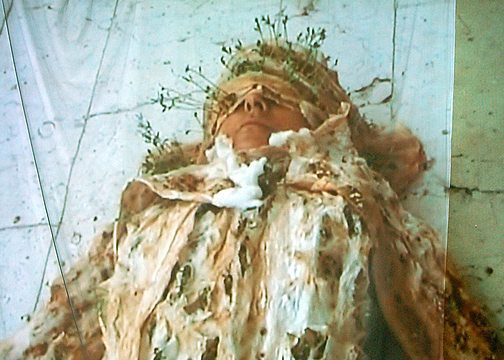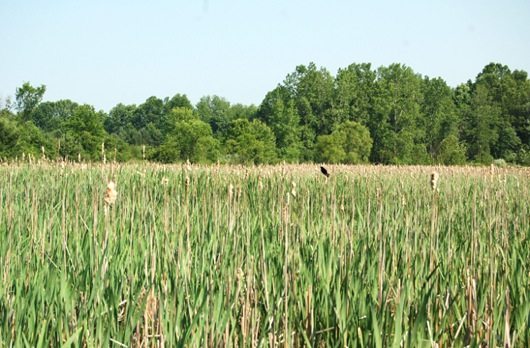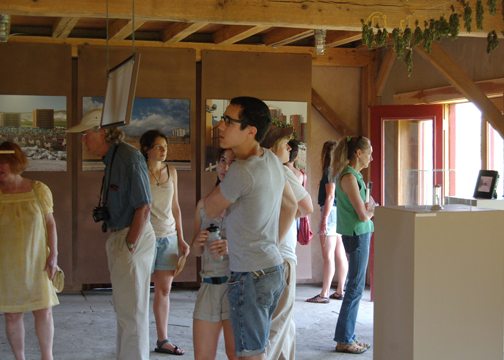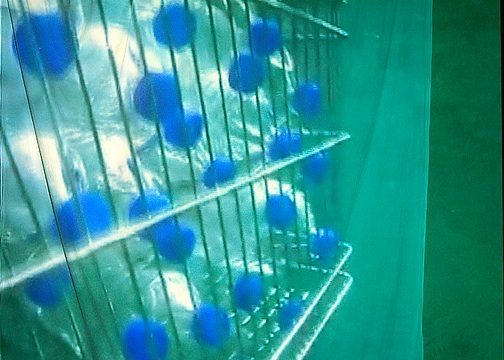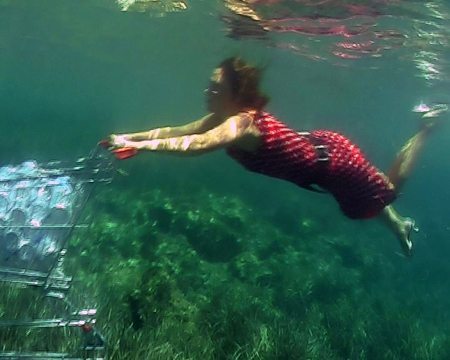EDITOR’S NOTE
In 2010 artists Nanette Yannuzzi and Arzu Ozkal brought ecoart by thirteen contemporary Turkish activist artists to America. The collaborative exhibit– RELIEF VALVE/SUBAP, was installed in a unique non-art farm venue at Oberlin College and Conservatory in Ohio where Yannuzzi and Ozkal were teaching studio art. Of special note, Nanette Yanuzzi is Associate Professor of Art at Oberlin College where she teaches a course entitled ‘Art and the Environment’ there. Ozkal (born in Turkey) was an Oberlin Visiting Professor and now teaches at San Diego State University, CA. They are the ‘we’ in this essay.
PART I: OHIO
I. EXHIBIT VENUE
INSTALLED IN THE TWO-STORY STRAW BALE meeting house/office building at Oberlin College’s New Agrarian Center (NAC), the exhibit Relief Valve/Subap featured thirteen Turkish artists who address their country’s contemporary environmental issues. In a variety of media from photography and video, to performance and installation, the selected art works provided an international perspective into land use, biodiversity and the controversy over genetically modified foods in Turkey today.
The New Agrarian Center is a 70 acre college & community organic farm and preserve ribboned on the east by Highway 20/10 and on the west by Oberlin College and Conservatory, a private liberal arts college. The town has a rich history of American Indian and African American contribution and was an important stop on the Underground Railroad.
II. CURATORIAL VISION
WE NAMED THE EXHIBITION RELIEF VALVE/ SUBAP to convey the sense of urgency we as curators feel about the environmental conditions our planet faces.
Our curatorial vision pivoted around notions of exchange and diversity as rudimentary to the discovery of self and other. We asked ourselves questions like, ‘What are artists in different countries thinking about relative to increasingly urgent environmental concerns;’ and, ‘How is this being expressed?’
It was important to us that selected works be exhibited in a site that engaged many of these issues and not just a typical art gallery. Situating works of art in a relative conceptual context often opens a dialogue that is somewhat different then what would take place in an art gallery or museum. Our intentions were, among others, to give Oberlin, Ohio audiences–whether farmers, students or passersby, a glimpse into how artists from another country are addressing similar environmental challenges in their own communities.
III. PREPARING THE EXHIBIT SPACE
FOR TWO DAYS WE CLEARED THE STRAW BALE, SOON to be gallery, of a years worth of farm detritus. Buckets of seeds, shovels, muck boots, dried garlic, old paperwork, tools, spider webs, and dust layered its interior. The work was physically demanding, and although we realized it would be, we were unprepared for just how important that process would become in deepening our understanding of the exhibition’s intentions.
Hauling seed bags, and water buckets while sweeping away mouse droppings is not something one often associates with mounting an exhibition of artwork. However, as we swept the un-sweepable rammed earth floors, scrubbed the wooden steps, and cleaned the large windows that opened onto acres of wetlands, what became almost palpable were the meanings created through ‘the unnamable’– as Michel deCerteau articulated in The Practice of Everyday Life (first published in French 1980; English 1984).
Irregular clay plastered walls, heavy hewn ceiling beams, gorgeous wooden doors and handrails were works of art themselves. Open windows and doors, rarely found in art galleries, streamed sunlight framing vistas of cattail and red-winged blackbirds, reminding visitors to take pause between works of art and observe, with the same attention, the living art beyond the thick walls of the straw bale. Why exhibit sometimes-nuanced works of art in this visual compendium? Had we never read Brian O’Doherty’s seminal text (Inside the White Cube, Artforum, 1976)) on the ideology of the gallery space?
IV. PHILOSOPHY
WEARYING ACCOUNTS OF GLOBAL WARMING, environmental pollution, deforesting, desertification, and the loss of biodiversity increasingly populate our daily digest. Farmlands are continually sacrificed for golf courses; fish farms are polluting our coasts; and species are disappearing from our planet at a dizzying rate. As individuals it’s easy to become apathetic as seldom are our objections seen or heard in the public realm. Many worry about their carbon footprint but rarely take an active role in protesting growing ignorance and environmental vandalism.
In his book (published in French 1989; English 2000) The Three Ecologies, philosopher and political activist Félix Guattari states that our ‘singularity is as endangered as those rare species that are disappearing from the planet everyday.’ Guattari’s focus is a theory of ‘ecosophy’ –mainly, three related ecologies of environmental, mental and social worlds and their coalescence into a methodological practice that argues for the broadening of our views to include their interdependence. By doing so, he argues, we will be able to affect enduring changes in our social, cultural, and natural environments.
Relief Valve/Subap offers the viewer a modest but rich antidote to this post-modern condition by opening a valve of visual discourse and creative exchange in the exploration of these ideas.
V. CONCLUSION ON VENUE
WHAT WE DIDN’T REALIZE, AND HADN’T PLANNED FOR, was the impact Oberlin viewers felt when experiencing the Turkish artworks in the farm setting. Many viewers commented on their excitement at seeing works of art outside a traditional venue. They were able to connect the work from Turkey with Oberlin’s own ecology. Responses included: ‘I never knew we had such a large wetland,’ and, ‘What exactly happens at this farm?’
EXHIBITION STATEMENT
‘Relief Valve’ serves as a locus for the interrogation and exploration of contemporary ideas about nature, offering a forum for political, aesthetic, and ethical discourse. Situating this exhibit at the New Agrarian Center will draw a diverse set of viewers and will benefit the farm as well as the artists. This merging of art and environment in venturing outside the gallery space is in itself a powerful statement about the potential of dialogue between art and sustainability.’
Janet Fiskio (Assistant Professor of Environmental Studies, Oberlin College & Conservatory)
PART II: TURKEY
I. CONTEMPORARY CONDITIONS
THE ACTIONS MANY POLITICIANS TAKE REGARDING the environment are politically motivated and heavily laced with lobbyist influence. Much of our government’s environmental policies and actions are ‘sold’ to the public via grandiose media performances aimed at buying votes. Unfortunately, many Turkish citizens are willing to play along, even when living under extreme conditions.
As the price of natural gas soars worldwide, more and more European cities face air pollution and its consequences due to the use of cheap and illegal energy resources (e.g., bootleg coal, etc.)
During a recent visit to Ankara, Turkey’s capital city and my (i.e. Ozkal) home, the winter air was so polluted that it was reported to have a negative impact on children walking to and from school each day. The sky was literally gray from the effects of burning cheap coal.
In response to public outcry the citizens of Ankara saw little more than media spectacle. Politicians sipped polluted tap water in front of the media to ‘prove’ that the Kızılırmak River’s water is safe to drink. Those antics add to continuing public malaise and feelings of political ineffectiveness.
As disturbing as these occurrences are, and as powerless as we as individuals may feel about changing them, there is much to be learned by becoming aware of how people in other countries are thinking about similar issues. Our interest in sharing stories, visual or oral, was the impetus behind bringing the work of Turkish artists to a small Mid West town.
II. ENVIRONMENTAL ACTIVISM
TURKEY IS IN THE MIDST OF EXPERIENCING THE tragic effects of environmental destruction, destruction that has been taking place since the beginning of its modernization process in 1960s.
Today, people living in rural areas observe changes much more vividly than the urban population. Even the subtle shifts in climate have had drastic effects on farmers, livestock breeders, and fishermen.
While stopping environmental destruction may be too ambitious, slowing down the damage is possible and vital for survival. Reaction against greedy corporations, resistance towards environmental legislation that serves profit-driven organizations is growing rapidly in Turkey thanks to the collective effort of activists, environmentalists, and cultural producers.
For example, lately there have been many efforts to shape public opinion regarding long-term consequences of government energy policies that allow the manipulation of riverbeds (by third-parties) for building hydroelectric turbines. Through independent media productions and documentaries the public is encouraged to develop a healthy and interrogative resistance towards the policies that limit the distribution of water—as water resources, springs and streams that have flowed freely in Anatolia for millennia have been shrinking in number every day.
Not too long ago in Turkey, clean water was a vast and free resource. One would come across fountains in public places and could access clean water freely. Today, free flowing streams are captured into conduits feeding the dams. Water reservoirs are contaminated due to heavy industrialization. Clean water supplies and springs are privatized and sold to corporations that produce bottled beverages. In many areas of the country, not only are public fountains are drying up but also tap water is becoming a health hazard—as it is becoming increasingly more profitable to sell the water instead of sanitizing it for free.
With this in mind as we curated Relief Valve/Subap, we looked for artists whose work engaged and publicly challenged these issues.
ARTISTS Genco Gülan and Ethem Özgüven
Genco Gülan and Ethem Özgüven expose through their artworks recent controversies around the commercialization of natural resources in Turkey. They use the aesthetics of place and the textures of natural resources, such as water, to evoke a sense of beauty and an equal sense of the everyday gone awry.
Gülan ‘s Shopping Water (2007) is a ten-minute film on the adverse effects of capitalism on global warming. Here, the audience sees a woman—wearing a red dress with white polka dots and fancy high heels, pushing a shopping cart filled with water bottles. As she moves between the aisles of a grocery store, the scene changes and we see her walking under water in Myndos, an ancient sunken city. While she continues to push the shopping cart under water at the same pace as when she was shopping in the aisle of the store, the audience becomes mesmerized in a captivating dream-like scene that blends reality into dystopia. We are lured into its texture and watery.
Gülan’s work raises an important question about the future of natural resources in Turkey: How can a peninsula that is bordered with such large bodies of water; filled with rich resources of springs, rivers and lakes face a water shortage?
He adds: ‘If we continue along our current path of consumption, we may all need to learn to live underwater.’
Ethem Özgüven’s Mediterranean is Over is primarily concerned with the pollution of water. Özgüven says, ‘Especially in the last twenty years, all species in the Mediterranean are in danger due to industrial or domestic waste.’
Mediterranean is Over is a series of short animations created by juxtaposing images of various artifacts that come out of the Mediterranean– rusty containers and industrial scraps photomontaged into fish and other sea creatures.
Short facts accompany these dystopian fantastic creatures, such as:
‘Although, it is forbidden, it is still common practice to use sonar, radar, dynamite, and harpoon together with light. With these illegal practices, fish have no chance to escape.’
Özgüven makes us question our inhumane and shortsighted decisions.
PART III. Interview with IZ OZTAT and DIKRAN TAS
SUBJECT: Genetically Modified Food Legislation
Nanette Yannuzzi: Your collaboration has developed over four years. Can you tell us how you met and why you decided to collaborate?
Iz Oztat: I first met Dikran Tas in 2008 as I was looking for a metalsmith who could make Milagros–small metal devotional objects used for wishes in the tradition of Eastern Orthodox churches. Dikran showed me some Milagros that his master has made and told that the tradition has died out. By spending time in their shop I started reflecting more on the relationship between metalsmithing and sacred relics. This craft [in Turkey] has historically related to the preservation of the sacred. It was very fruitful for Dikran and me to research examples from our own past and belongings to reinterpret existing sacred relics.
The first object I commissioned Dikran to make was Hacer-ül Esved Protective Cover, a silver case to hold together the Hacer-ül Esved stone in Mekke. This stone is believed to come from heaven and is touched by all the visitors to Mekke for pilgrimage. As Dikran was working on this object, Hrant Dink, an Armenian journalist who devoted his life to starting a public dialogue between the Ermenians and Turks, was killed. I commissioned Dikran to make a portrait of Hrant, similar to saint icons made of silver for the church alters. Dikran’s master has made many portraits for Turkish army and state officials but this was the first portrait that Dikran made.
This series of works allowed us to research the Muslim and Christian heritage that is available in Istanbul, and reflect on it from a contemporary and critical perspective. For Dikran it was a way to approach his craft as a metal smith from a more conceptual point of view. For me, it is crucial to make connections between this historical craft that is dying out and contemporary art and to invent alternatives to make it sustainable.
NY: The sculpture you submitted to Relief Valve/Subap reminded many viewers of some sort of relic. It was placed under glass, it contained highly crafted silver and blown glass and encased something very special and rare, in this case, a tiny seed. Can you tell us about this compelling work. What where you thinking about, how did you arrive at the form and what did you hope viewers in the US would take away from it?
IO: Sacred Relic of The Future: GMO-Free Wheat Seed came after these objects and is the first one to be exhibited. I think it is important to reflect on how these objects meet a public, in which contexts they are exhibited because they have a reference to the sacred, something that has been lost with the rise of secular art venues.
What happens to an object with a claim to the sacred when it enters a secular setting? Sacred Relic of the Future is inspired by a reliquaries made for preserving the hair of Prophet Muhammad, which is exhibited in the Sacred Relics Department of Topkapı Palace in Istanbul.
Since we have been working together for a long time by now, a short visit to the museum was enough to sketch out our version. I got the seed from an archeologist friend, who found some wheat seeds in an excavation site. Will this species of wheat survive only if we preserve it like a sacred relic from all the genetically modified breeds that are replacing it? In terms of the work being shown in another geography, this is a challenge I face every time I work with a local reference. It is a very thin line between exoticizing your own heritage versus being able to say something relevant through it… With the title, and the careful craft of the object, I hoped the feeling of being a sacred relic could be communicated. The title is quiet didactic but it was necessary…
NY: The idea that a single seed can, within the context of contemporary society, so easily signify a sense of rarity is still difficult for many of us to wrap our minds around yet eleven years into the new century it’s glaring clear. What is your experience of genetically modified food and seeds in Turkey, a country that for many years banned the importation of genetically modified foods.
IO: When doing research for this work, I became familiar with resistance movements in Turkey that are trying to resist the laws that allow for more and more genetically modified species to be produced in Turkey. Big companies like Monsanto are very influential in passing these laws and invading the local market. In response, there are farmers gathering to exchange seeds for local breeds that have evolved over thousands of years and will disappear if they are not planted and harvested.
I had already done the work when I learnt that the best way to preserve a seed is by planting it.


